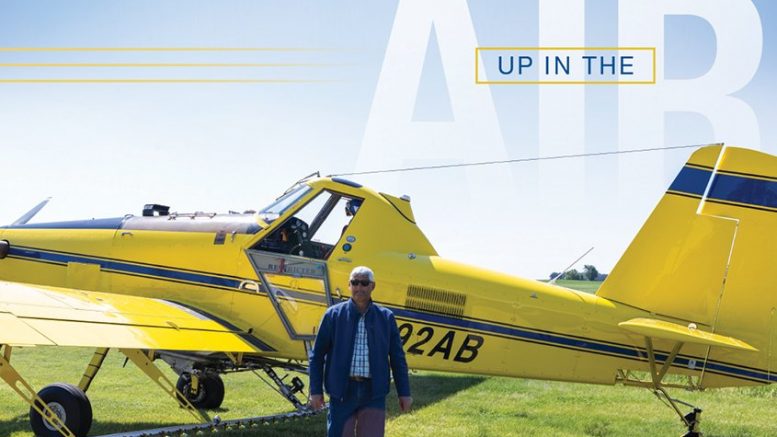|
Click to listen to this article
|
By Laura Temple/ Photography by Haley McCormick
- Aerial application can help growers cover more acres faster.
- Modern precision equipment guides aerial applications.
- Aerial application reduces opportunities for soil compaction.
What goes up, must come down.
Just how aerial fungicide applications come down is essential for efficacy and safety. To help make aerial application viable for growers struggling to make timely fungicide applications, the National Agricultural Aviators Association holds fly-in clinics across the country.
Technology advances continuously improve the quality and reliability of aerial application. Through fly-in clinics, pilots learn how to use that technology.
Garrett Lindell, pilot and executive director of the Illinois Agricultural Aviation Association, also touts the value of calibration events, which he says are held in Illinois twice each year.
Demand for services like Lindell’s has grown with the use of in-season fungicides to prevent and control diseases and improve plant health in corn, soybeans, small grains and other crops. He estimates that in-season fungicide treatment makes up about 85% of his business.
Timely Treatment
The agronomic window for fungicide applications depends on crop maturity, disease pressure and weather conditions. Rain not only can delay application timing, it also can speed up both crop and disease development.
“There’s a tight window to apply these products, and we can apply them substantially quicker,” Lindell says. “When it rains, airplanes can get back to work as soon as the weather passes.”
Aerial application often is the better option following rain because running equipment through wet soils causes compaction, and that can lead to long-lasting adverse crop impacts, especially in heavy clay soils, says Blake Miller, agronomic service representative for Syngenta in central Illinois. Plus, growers sometimes struggle to navigate equipment through wet soil and end up rolling over crop rows, reducing yield.
Applied Technology
Some farmers are uncomfortable with aerial application, which happens at high speeds over their fields.
From those farmers, Miller says, “common questions include ‘Will applications be accurate?’ and ‘Will the right field be sprayed?’”
Syngenta sponsors calibration events like Operation S.A.F.E. to address accuracy. Miller believes the calibration process ensures growers get the best application possible, especially when coupled with the technology currently available in fungicides.
SDHI fungicides provide residual action that prevent disease and allow most fields to be treated just once, which Miller says is ideal for both farmers and aerial applicators.

Aerial Calibration
Calibration means the right spray volume leaves the aircraft for every acre covered, according to Bretthauer.
Pilots use speed, airflow, nozzle type and more to push fungicides into the crop canopy, while mitigating drift. For each calibration series, a pilot makes three passes over an established flight line, spraying water containing fluorescent dye. Each series of passes targets a specific spray volume and droplet size goal, Bretthauer says.
An Operation S.A.F.E. fly-in clinic addresses three main dynamics:
- Spray pattern uniformity
Like ground application, aerial application must deposit the same amount of product everywhere. Booms and nozzles are mounted to account for how propellers, wings and helicopter rotors push air around the aircraft and direct liquid flow from each nozzle. - Swath width
Aircraft wings create a wake of air that pushes spray down and away, allowing a boom to effectively cover an area wider than its length. Airplanes spray trapezoidal patterns, so each pass partially overlaps to ensure even coverage across the target field. Calibration determines the exact swath width and overlap needed for consistency. - Droplet size
Aircraft speed is the dominant factor in determining spray droplet size because the high-speed air around the plane shears the liquid as it leaves nozzles. Droplet size affects plant coverage, so minimizing fine droplets limits drift.
Confidence in Coverage
Matt Gill, University of Illinois Extension specialist in application technology, often works calibration events. He helped develop the current software used to analyze data collected from each spray pass.
“This iteration of the software uses new technology to analyze spray patterns,” Gill says. “A digital spectrometer measures the dye captured on the cotton string the planes fly over. It provides a significantly more detailed picture of spray patterns than the previous technology.”
Cotton string and cast-coated paper cards, which are color-sensitive, measure spray deposition during calibration. Using a high-resolution scanner, Gill scans the cast-coated paper cards. The software isolates and measures each droplet stain from the spray, then back-calculates the droplet size that created it. After each stain is measured, the overall droplet spectrum is determined.
During the clinics, pilots receive a report with a pictograph showing their spray pattern and swath width, as well as their droplet size. Using this data, each pilot consults with the Operation S.A.F.E. analyst, addressing areas of concern and other factors to improve application. If warranted, additional calibration passes are made that same day until pilots achieve the desired spray pattern and droplet size.
As a pilot, Lindell uses this information to improve accuracy and show proof of the results.
“I can put my calibration paperwork in front of potential customers to reassure them that we’re doing the best job possible,” he says. “They can see the value of aerial application.”
SOURCE: SYNGENTA

